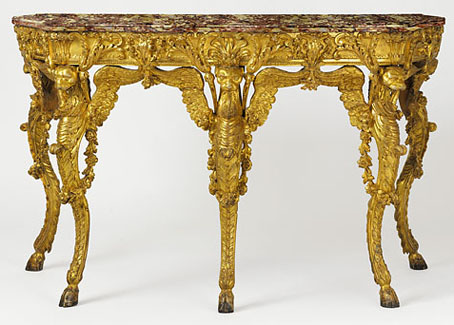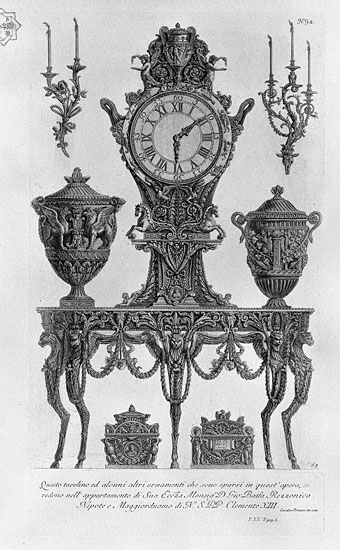
Pier table for Cardinal Rezzonico (c. 1768).
This ostentatious object is on display at the Cooper-Hewitt National Design Museum in an exhibition devoted to Piranesi’s work as a designer. Piranesi (whose work adorns the current {feuilleton} header) is far more well-known for his Carceri d’Invenzione and Vedute di Roma prints than for his furniture design, of course, so this exhibition addresses a side of the artist/architect which is rarely explored outside the more extensive books about his work. I’d seen this table before in black and white photographs in John Wilton-Ely’s substantial monograph, The Mind and Art of Giovanni Battista Piranesi (1978) but those photos don’t fully convey its lavish (some might say gaudy) effect.
The exhibition runs from September 14, 2007–January 20, 2008. From the Cooper-Hewitt site:
This exhibition examines the artist’s role in the reform of architecture and design from the 18th century to the present. This is the first museum exhibition to show Piranesi’s full range and influence as a designer of architecture, elaborate interiors and exquisite furnishings. On view will be etchings, original drawings and prints by Piranesi, as well as a selection of three-dimensional objects. In addition to his better-known architectural projects, Piranesi also designed fantastic chimneypieces, carriage works, furniture, light fixtures and other decorative pieces. The exhibition is co-curated by Dr. Sarah E. Lawrence, director, Master’s Program in the history of decorative arts and design, Cooper-Hewitt, National Design Museum, and John Wilton-Ely, professor emeritus, University of Hull.
Diverse Maniere…, Open to Chimneypiece: Griffon Monopods on the Jambs (1769).
The original table design appeared in Diverse Maniere, a collection of prints showing design for clocks, furniture and fireplaces. Many of these are the most bizarre and detailed inventions in Piranesi’s corpus, especially the elaborate Egyptian-themed fireplaces. Very few of these confections were built at all but a number of the prints are in the exhibition and can be seen at its very elegant website.
• NYT feature on Piranesi and the Cooper-Hewitt exhibition
Elsewhere on { feuilleton }
• The etching and engraving archive


Wow, I’ve only known Peranesi from his drawings. I had no idea anything was actually made!
One can view that table in two ways: in context, and out of context. (The context being the time, place, and situation of its construction.) Taken on it’s own, just as a thing in and of itself, it really is quite spectacular. The ornateness of the decoration is not that far removed from Asian artifacts of a much older era. If Piranesi’s goal was to lift the consciousness of the viewer into another realm, he may well have succeeded.
Plus, ya gotta love a table that appears to have hooves!
Yes, those are indeed hooves. I’d guess his primary concern was to produce something on a par with the Classical world since he was a great antiquarian. Having said that, his pastiches of Roman and Egyptian styles are very fanciful, the Egyptian stuff especially.
The works of his which *did* change consciousness (although not necessarily in an upward manner!) are the Carceri series of prints showing imaginary prisons. De Quincy writes about them in Confessions of an Opium Eater and they’ve been stimulating imaginations ever since.